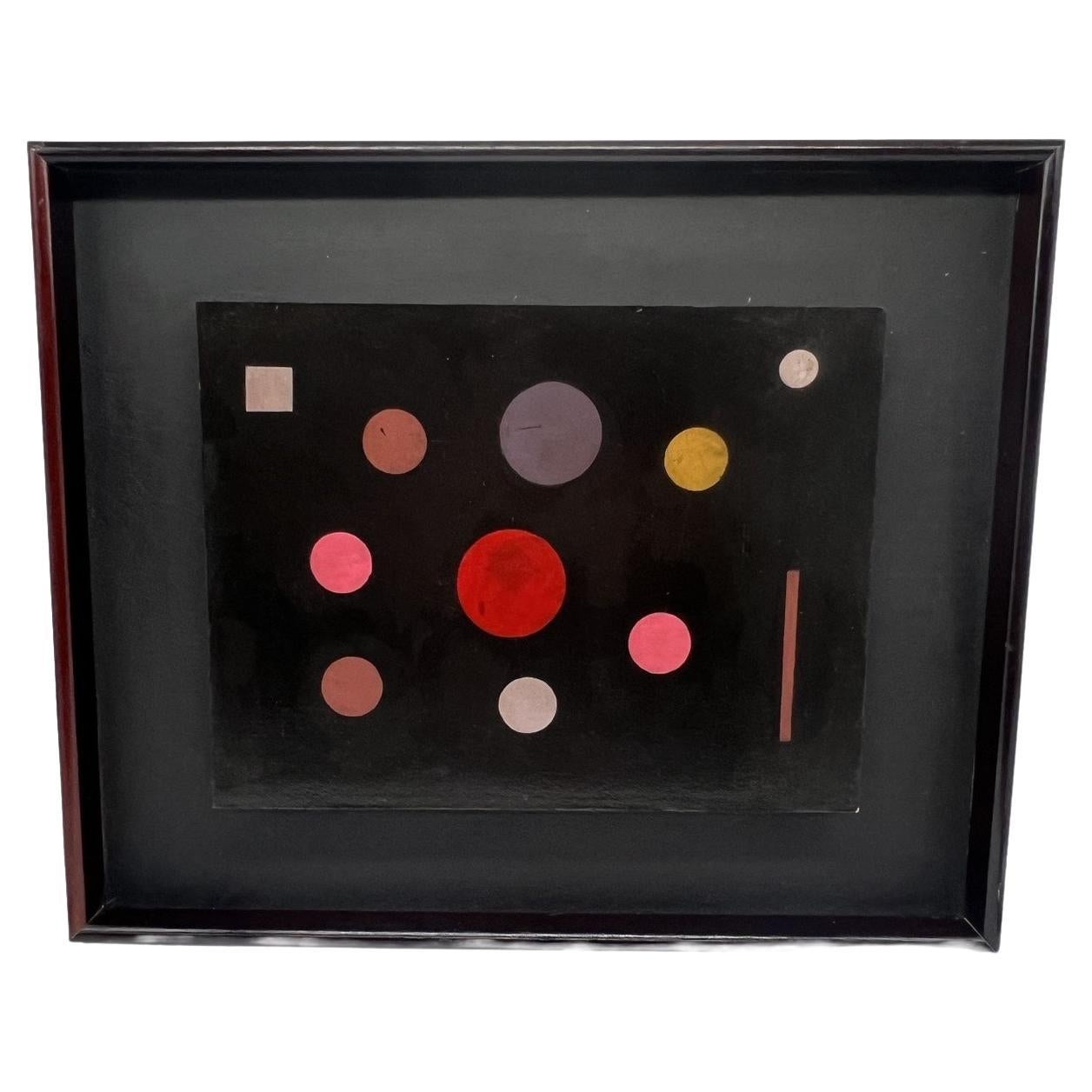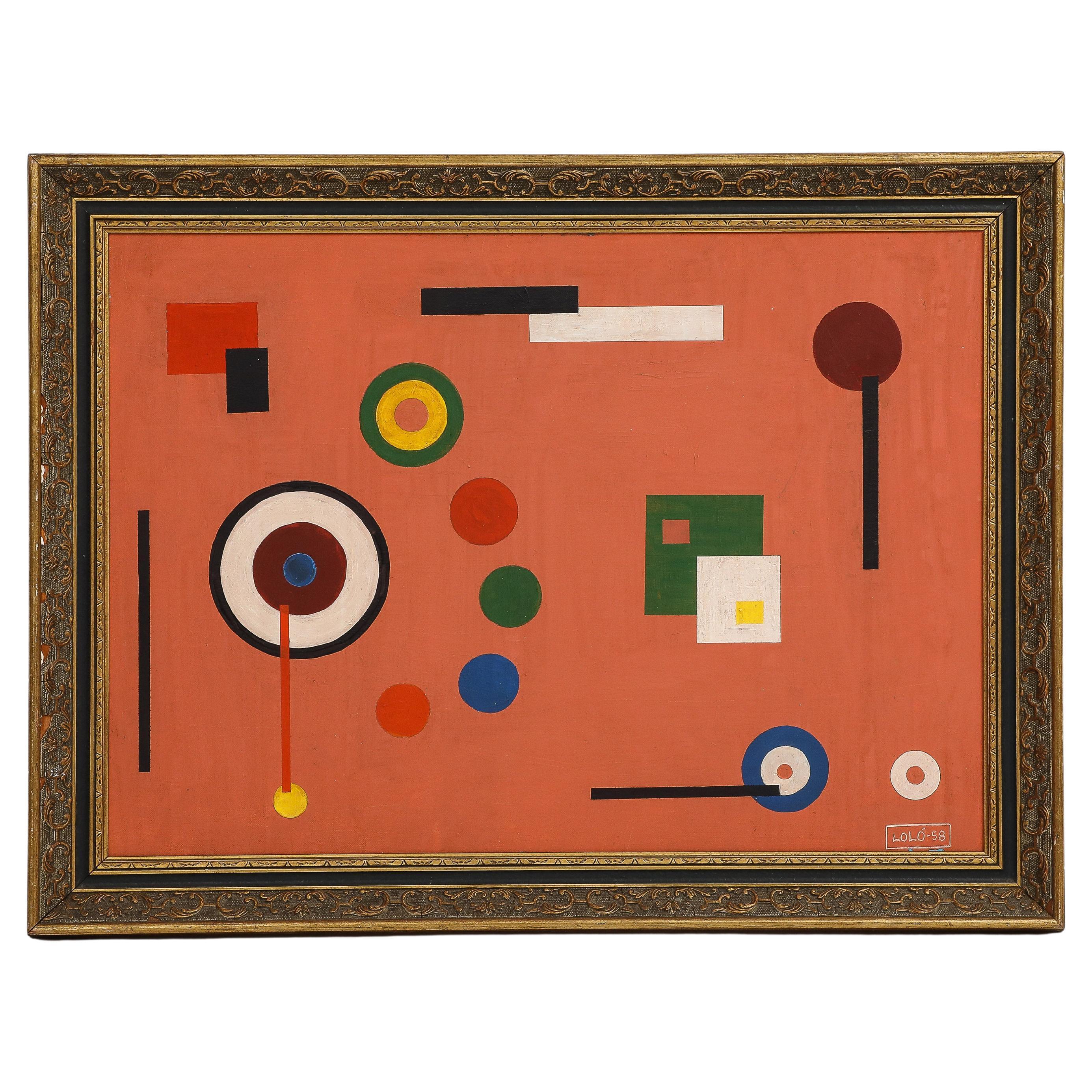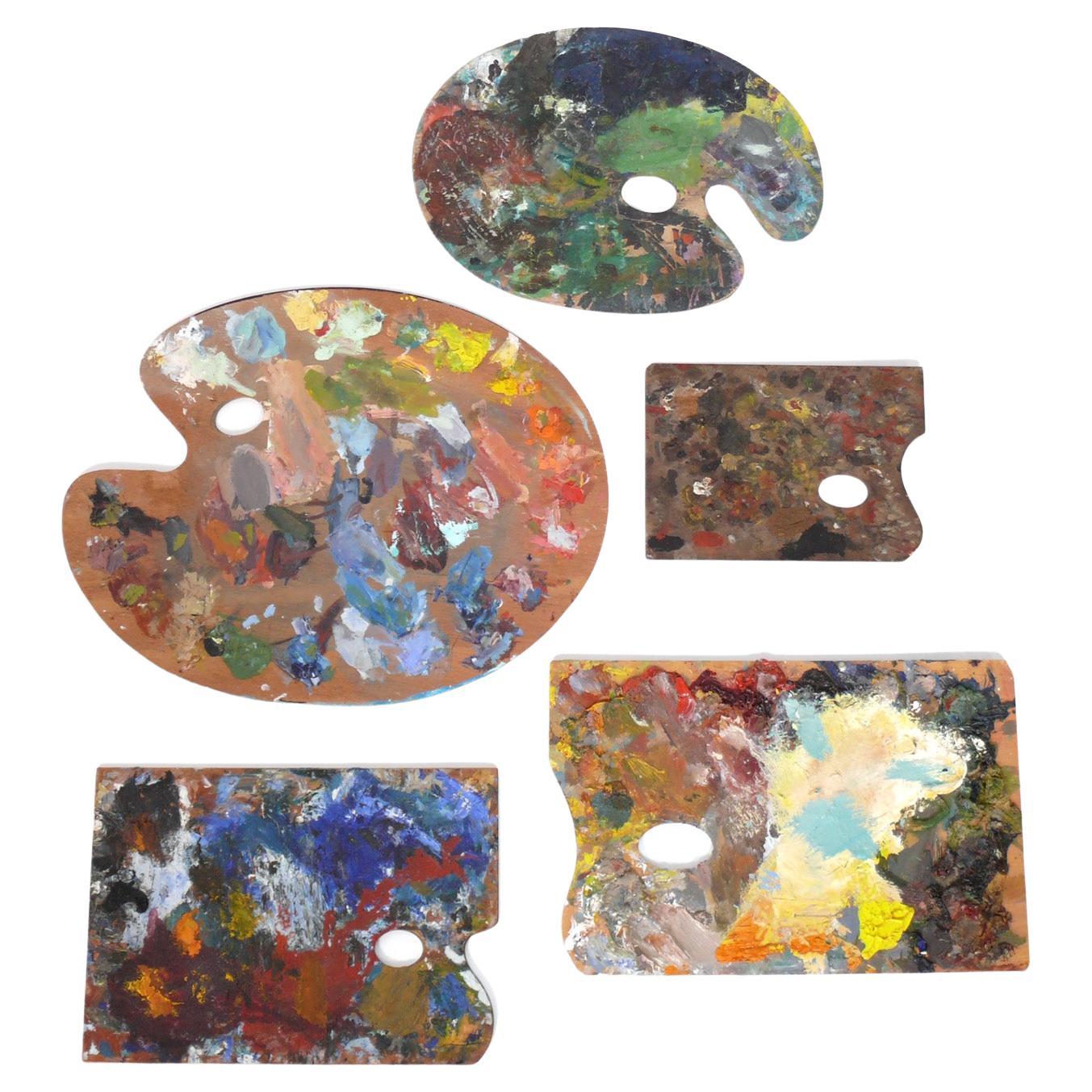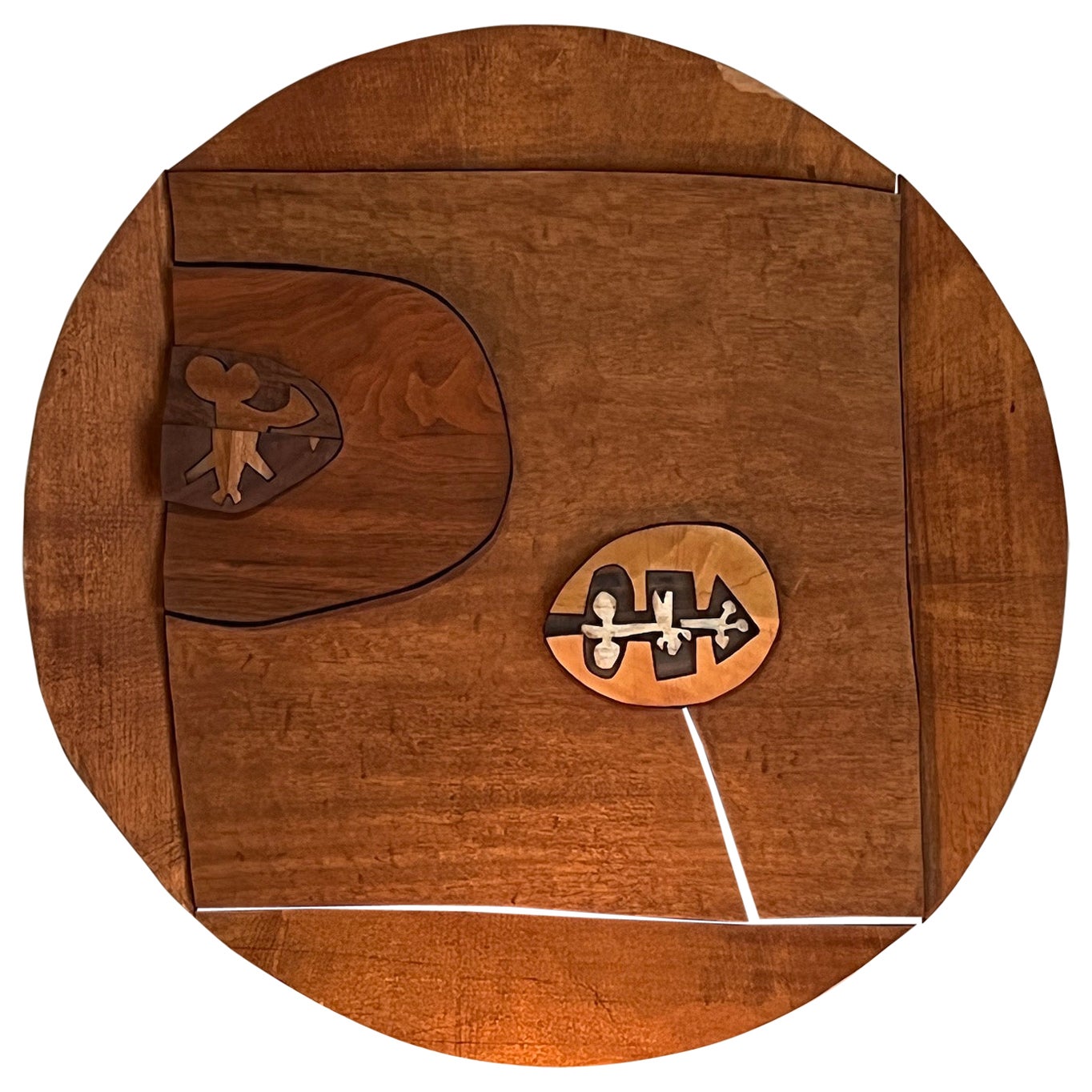Items Similar to Dolores "Loló" Soldevilla Geometric Abstraction Wall Sculpture Cuban Painting
Want more images or videos?
Request additional images or videos from the seller
1 of 10
Dolores "Loló" Soldevilla Geometric Abstraction Wall Sculpture Cuban Painting
About the Item
Dolores "Loló" Soldevilla Geometric Abstraction Wall Sculpture Cuban Painting
Offered for sale is an untitled original work of art by Cuban artist Loló Soldevilla (September 6 – October 19, 2019) signed and dated 1955. This piece comes with a certificate of authenticity signed by Pedro de Oraa as pictured.
A key figure in the Concrete Art movement, artist, curator, and gallery owner Loló Soldevilla —born Dolores Soldevilla Nieto —was the only woman to be strongly associated with geometric abstraction in Cuba. She was named Cuba’s Cultural Attaché to Europe in 1949. Upon returning to Havana from Paris, she and fellow artist Pedro de Oraá founded Galería de Arte Color-Luz, which was instrumental in promoting abstract art in Cuba in the 1950s and ’60s. The gallery served as an incubator for Los Diez Pintores Concretos (Ten Concrete Artists), a group of Cuban artists that included Sandú Darié and José María Mijares, and of which Soldevilla was the only female member. Though her paintings and sculptures of delicately arranged geometric shapes were influential among mid-century Cuban artists, the rise of Fidel Castro ushered in an era of political repression and her work receded from public view.
Dolores "Loló" Soldevilla (1901- 1971) was one of the only women to be prominently associated with the development of geometric abstraction in Cuba, and one of the key figures responsible for promoting its development from the 1950s onward.
Loló Soldevilla was a passionate, largely self-taught artist whose career blossomed in the 1950s. A self-styled impresario and autodidact, she was a formidable artistic talent and an astute cultural promoter. Following earlier professional turns as a musician, political activist and party politician in Cuba, Loló was appointed the country’s cultural attaché to Europe in 1949. Residing in Paris, she began studying in the ateliers of prominent European artists. Although she did not take up painting and sculpture until her late-forties, she quickly gained command of her métier and was soon exhibiting her work in Parisian galleries and Salons transitioning from figuration to abstraction. By 1950, Loló was producing abstract paintings and sculptures inspired by geometric forms. In the ensuing years, Soldevilla developed her groundbreaking Color Luz theory that opened pathways to her Reliefs Lumineux, unique constructions that incorporated light as a working element in abstract designs, which premiered in Paris at the 1955 Salon des Réalités Nouvelles. Her paintings, collages and panel constructions explored the dynamics of light, shadow and relief, suggesting movement and rhythm through the use of geometric pattern and color.
After returning to Havana in 1956, Loló played an active role as an artist, curator, and gallery owner. A fierce advocate for social justice, women’s rights and the working class in the 1930-40s, she began championing abstraction through ambitious international projects, gaining attention for her voice within the island’s abstractionist landscape and serving as a vital link between Cuba, Europe and Latin America. She organized the important exhibition Pintura de hoy: Vanguardia de la Escuela de Paris (Painting Today: The Avant-Garde of the School of Paris) at the Palacio de Bellas Artes, Havana, which featured the work of forty-six leading Hard-Edge, Op and Kinetic artists, including Jean Arp, Sonia Delaunay and Jesús Rafael Soto, amongst others. This pivotal exhibition introduced Cuban audiences to international abstract art for the first time.
In October 1957, Soldevilla along with fellow artist Pedro de Oraá founded the Galería de Arte Color Luz, a venue instrumental in fostering the development of abstract art in Cuba and solidifying the presence of the concrete art movement on the island. The gallery served as the incubator for a group of artists who would name themselves “10 Pintores Concretos,” of which Loló was the sole female member, its most public face, and strongest force. As Castro’s revolution began to transform Cuban culture, abstraction, though never explicitly censored, was deemed “obsolete” and “out of touch with the new society.” Although Loló’s activities around the visual arts diminished, she stayed active establishing a new association, Grupo Espacio, and continued to paint and exhibit her work until her death in 1971.
- Creator:Loló Soldevilla (Artist)
- Dimensions:Height: 47.25 in (120.02 cm)Width: 23.5 in (59.69 cm)Depth: 1.75 in (4.45 cm)
- Style:Mid-Century Modern (Of the Period)
- Materials and Techniques:
- Place of Origin:
- Period:
- Date of Manufacture:1955
- Condition:Wear consistent with age and use. As found original condition.
- Seller Location:Miami, FL
- Reference Number:1stDibs: LU1974325709502
About the Seller
4.9
Platinum Seller
These expertly vetted sellers are 1stDibs' most experienced sellers and are rated highest by our customers.
Established in 1991
1stDibs seller since 2016
1,044 sales on 1stDibs
Typical response time: 1 hour
- ShippingRetrieving quote...Ships From: Miami, FL
- Return PolicyA return for this item may be initiated within 7 days of delivery.
More From This SellerView All
- “Loló” Soldevilla, Oil on Wood, Untitled, Signed and Dated 1959By Loló SoldevillaLocated in Miami, FL“Loló” Soldevilla (Cuba 1901- 1971) oil on wood, Untitled, signed and dated 1959 Offered for sale is an untitled mixed media and collage on wood by ...Category
Mid-20th Century Cuban Paintings
MaterialsWood
- 1980s Dolores Nathan Abstract Painting "Situation #320" on Canvas.Located in Miami, FL1980s Dolores Nathan Abstract Painting "Situation #320" on Canvas. Offered for sale is an acrylic abstract painting on canvas titled "Situation #320" by the Miami artist Dolores Nathan. This large and colorful figurative painting depicts a lively furniture auction...Category
Late 20th Century American Modern Paintings
MaterialsCanvas, Acrylic, Wood
- 1950s Frederic Weinberg Wrought Iron Wall Sculpture of a FencerBy Frederic WeinbergLocated in Miami, FL1950s Frederic Weinberg Wrought Iron Wall Sculpture of a Fencer Offered for sale is a wonderful wrought iron wall sculpture by Frederic Weinberg in the 1950s. The sculpture depict...Category
Mid-20th Century American Mid-Century Modern Wall-mounted Sculptures
MaterialsWrought Iron
- Cuban American Artist Juan Navarrette Oil PaintingBy Juan NavarreteLocated in Miami, FLCuban American Artist Juan Navarrette Oil Painting An oil on canvas by seasoned Cuban-American artist Juan Navarrette titled "Comienzo del Amor". Juan A. Navarrette was born in Hav...Category
Early 2000s American Modern Paintings
MaterialsCanvas
- Tropical Exterior Metal Painted Palm Tree Wall SculptureLocated in Miami, FLTropical exterior metal painted palm tree wall sculpture. Offered for sale is a tropical, outdoor mixed metal painted palm tree wall sculpt...Category
Late 20th Century American Wall-mounted Sculptures
MaterialsMetal, Copper
- Cuban-American Artist Juan Navarette Watercolor Painting, "Fish 3"By Juan NavarreteLocated in Miami, FLCuban-American Artist Juan Navarette Watercolor Painting Signed "Fish #3" Offered for sale is an original 1993 watercolor painting on paper by the Cuban-American Artist Juan Navaret...Category
Late 20th Century American Modern Paintings
MaterialsWire
You May Also Like
- Lolo Soldevilla "Untitled" Oil on Canvas Cuban Master Geometric Abstract ArtistBy Loló SoldevillaLocated in Atlanta, GADolores "Lolo" Soldevilla Neito (Cuban, 1901-1971), circa 1955. A very important piece by a leading female artist in the Cuban abstract movement. This painting conducted in oil and likely tempera on canvas laid to board. Her colorful geometric paintings evoke mixed emotions and feelings - we have always viewed this piece as an homage to our solar system. In its original frame, identical framing to nearly all of her pieces. Signed to the lower right "LoLo". Measuring 13.75" w x 10.5" h (image), 20.25" w x 16.875" h (framed). Provenance: From the collection of a Cuban art collector in Canton, Massachusetts. Below is a very detailed biography of the artist from her website dedicated to her work and life. María de los Dolores (Loló) Juana Soldevilla Nieto was born June 24, 1901 in the Pinar del Río Province, Cuba. She was the third child of a piano teacher, María Paula Bathilda Nieto Lannes and a merchant, Raoúl Soldevilla Seballos, both originally from Pinar del Río. Her maternal grandparents were Severo Nieto (Pontevedra, Spain) and Lorenza Lannes Díaz, baptized in Pinar del Río. Her paternal grandparents were Pedro Soldevilla Martí (Caracas, Venezuela) and Dolores Seballos Bermúdez (Habana, Cuba). Loló was a precocious, restless, and curious girl. She was surrounded in her early years in Pinar del Río by a numerous, charismatic, and cultured family. Her mother’s and uncle’s instructions provided a learning environment, and from an early age she practiced reading and writing, singing, piano, and the appreciation of various art forms such as painting and theater. Also as a child she was reflective of social issues since she was surrounded by ideals and actions that defined her family during that time. Around 1911 Loló is translated to Havana with her family. There she studied and graduated from piano and vocal performance (soprano). She trained her voice with professor Zoila Gálvez in the Municipal Academy of Havana and violin with professor Casimiro Zertucha in the Falcón Conservatory. In 1926 Loló went to live with her mother and sister near Paseo del Prado, where they remained until they were evacuated during the catastrophic hurricane of that same year. At age 25, Loló married Manuel de Jesús Nazario Barba Bonen, a professional pianist. From this marriage were born her three children, Haydée, Magaly, and Pasto; the latter passing at one year old. In 1934 she founds the “Loló Orchestra,” composed of women and with a Latin American and Cuban repertoire. She directed the orchestra and played the violin. They performed regularly in the “Aires Libres” in the cafés of the Paseo del Prado in Havana. During these years Loló refines her political ideals and actions, stemming from her early education in Pinar del Río and family traditions. She takes part in diverse activities against the government of Machado and she was imprisoned more than once in the Women’s Detention Center of Guanabacoa. In 1937 she becomes a member of the National Executive Committee of the Cuban Revolutionary Party (Authentic), where she carried out activities according to that historical moment. In 1940 Loló marries syndicalist Eusebio Mujal and they divorce four years later due to the discrepancy of their political ideas. In 1946 she represented the Authentic Party as a member of the House Representatives of the Oriente Province, where she was named President of the Commission of Press and publicity. She travels to Prague in 1947 to participate in the first session of the International Women’s Federation. Loló was charged with representing and defending the ideals of Cuban women, their social problems, the defense of children, etc. In 1948 she became a member of the House of Representatives of Cuba. Between her actions one could mention the public denouncement about the assassination of the farm workers leader Sabino Pupo, the proposal for a law for minor courts, the retributions due to sugar workers, among other demands. That same year she was invited by the American Federation of Art in Washington and she visited museums in Boston, Philadelphia, Chicago, and New York. Later that year she travelled to Paris and begins to paint under the guidance of her painter friend Wifredo Lam. At that time she creates her first small and large format sculptures, drawings, portraits, and projects for mural paintings. In February of 1949 she is named Cultural Attaché in the Cuban Embassy in France. From that moment on, her career as a visual artist deploys in intense and varied studies and exhibitions. She matriculates in the “Académie de la Grande Chaumière” in Paris and begins her sculpture studies with professors Léopold Kretz and Ossip Zadkine. In the 1950s she travels across Europe with her daughter Magaly. In Spain, she meets Eusebio Sempre who dedicated the poem collection “Claridad de Vivir. Versos Populares.” Together with Lam, she visits museums and galleries in Switzerland, Holland, Belgium, Great Britain, Austria, and Eastern Germany. She continues her studies in various workshops and attends several conferences on new artistic trends. She also continues establishing connections with painters, sculptors, musicians, writers, photographers, and artistic personalities of Cuba and the world. She exhibits her work in various individual and collective shows, such as an exhibition in Tampa. She returns to Cuba and exhibits there for the first time. In the show “Loló esculturas” (November 23-27, 1950) in the Lyceum Lawn Tennis Club of Havana she presented 22 sculptures and one oil painting. Back to Paris she participates in various collective exhibitions including Salon d’Automne Grand Palais del Champs Elysées; Peintres, graveurs et Sculpteurs Etrangeres (Ecole Nationale del Beaux-Arts, Paris). She also participates in Jubilé International in the Cité Universitaire, among others. There she becomes part of “The Dissidents,” and she travels to Mexico invited by the painter Felipe Orlando. In 1951 she promotes and organizes, as Cultural Attaché of Cuba in Paris, the exhibition, “Art cubain contemporain, in the Musée National d’Art Moderne de la Ville de Paris. She includes works of Pedro Alvarez...Category
Mid-20th Century Cuban Mid-Century Modern Paintings
MaterialsCanvas, Masonite, Paint
- Painting by Cuban Artist Lolo Soldevilla, Oil on Canvas, Signed & Dated 1958Located in Chicago, ILMidcentury oil on canvas painting by Cuban artist Lolo Soldevilla, signed and dated 1958. Biography: 1901 - 1971. Lolo Soldevilla (1901-1971) was a painter, sculptor, draftsman and...Category
Vintage 1950s Cuban Mid-Century Modern Paintings
MaterialsPaint
- Collection of Vintage Painter's Palettes, Wall SculptureLocated in Atlanta, GACollection of Vintage Artist's Palettes, American, circa 1940s - 1960s. The largest palette measures 15.5"H x 19.5"W. The smallest measures 7.5"H x 10.5"W.Category
Vintage 1940s American Mid-Century Modern Paintings
MaterialsWood, Paint
- Hugh Townley Wall Mounted Sculpture, 1962Located in Dallas, TXA mahogany wall mounted sculpture by Hugh Townley, 1962.Category
Vintage 1960s Wall-mounted Sculptures
MaterialsMahogany
- Painted Wall Sculpture by Roger NeyratLocated in Brooklyn, NYRoger Neyrat is a visual artist, painter, sculptor born in 1932, student of l'Ecole des Beaux Arts in Paris He joined the research center of Madi in 195...Category
1990s Wall-mounted Sculptures
MaterialsWood, Paper
- Wall Mounted Sculpture Construction by George Cohen d. 1972Located in Peabody, MAThree dimensional construction of painted and mounted blocks by the Chicago Imagist George Marshall Cohen (1919-1999). Cohen was a founder of the Chicag...Category
Vintage 1970s American Mid-Century Modern Wall-mounted Sculptures
MaterialsWood, Paint





